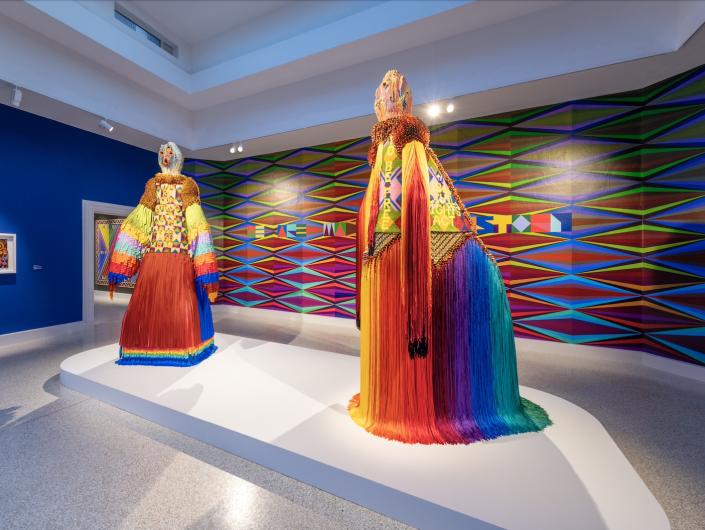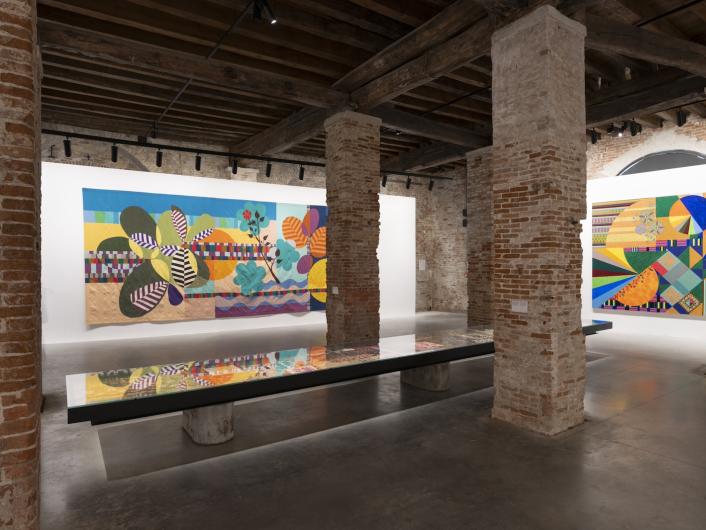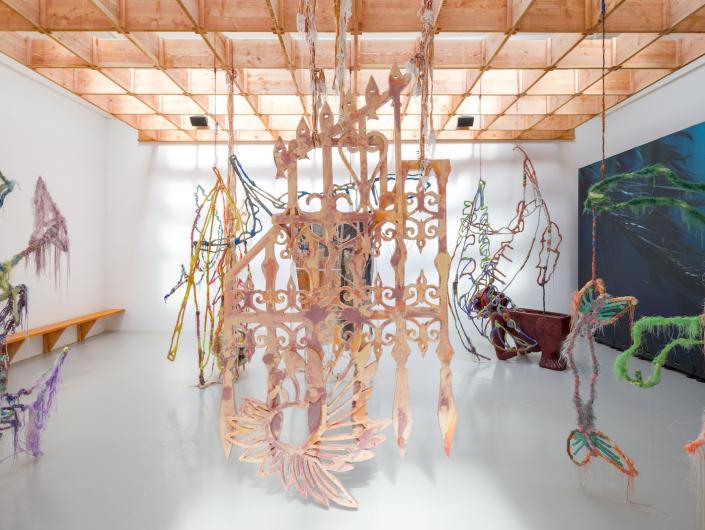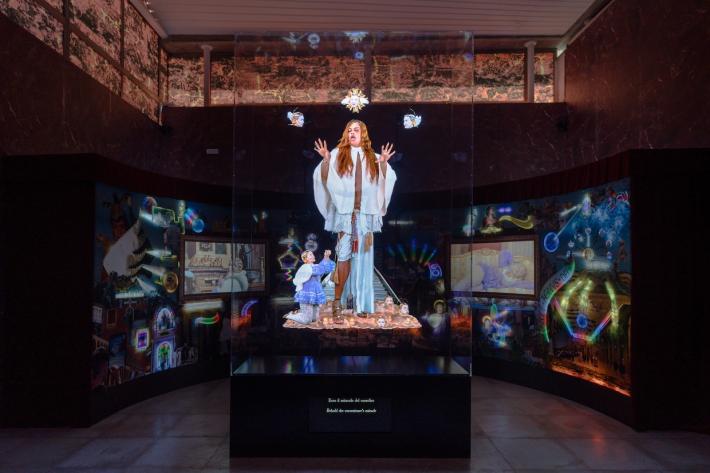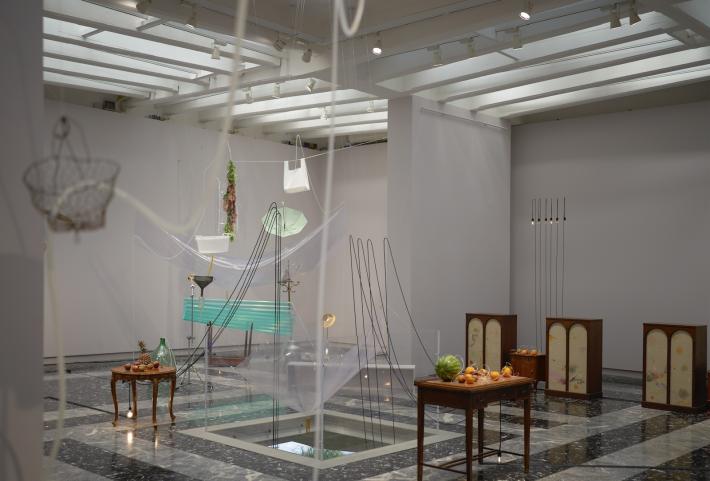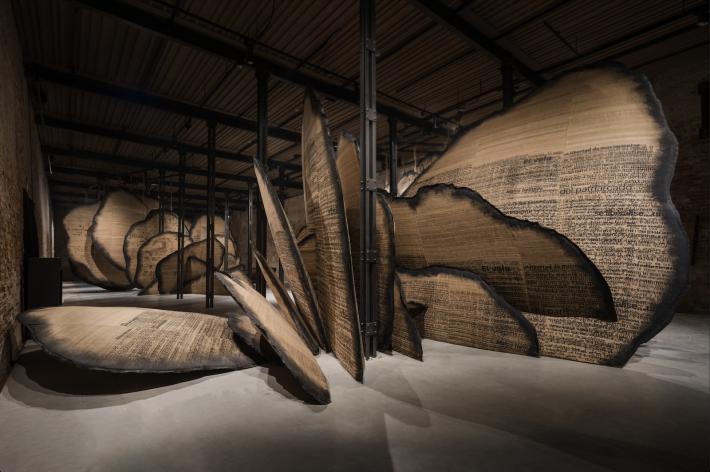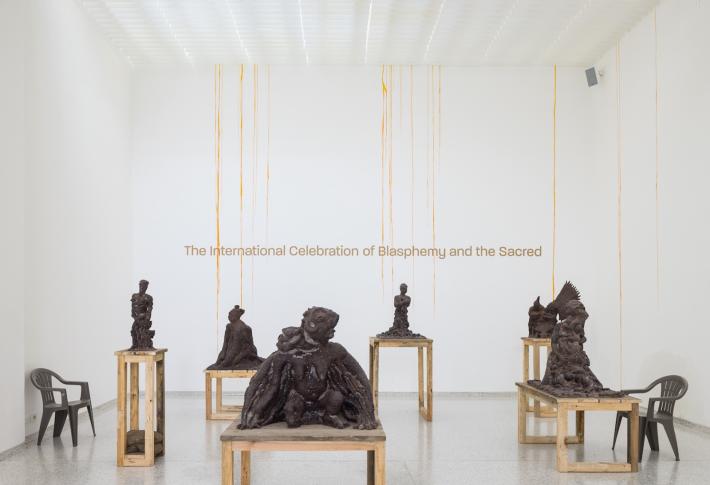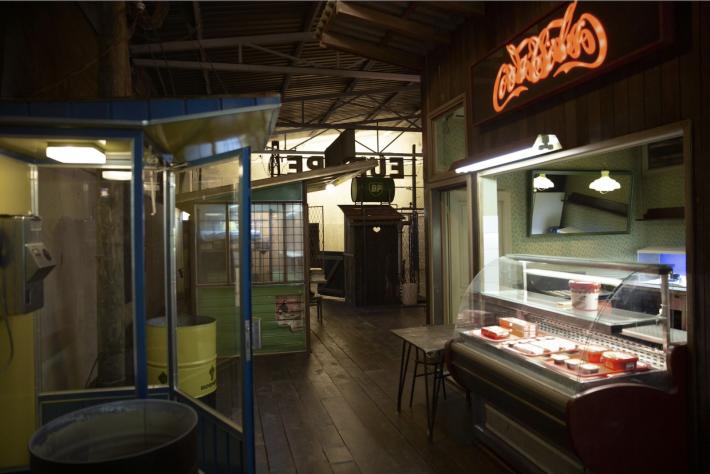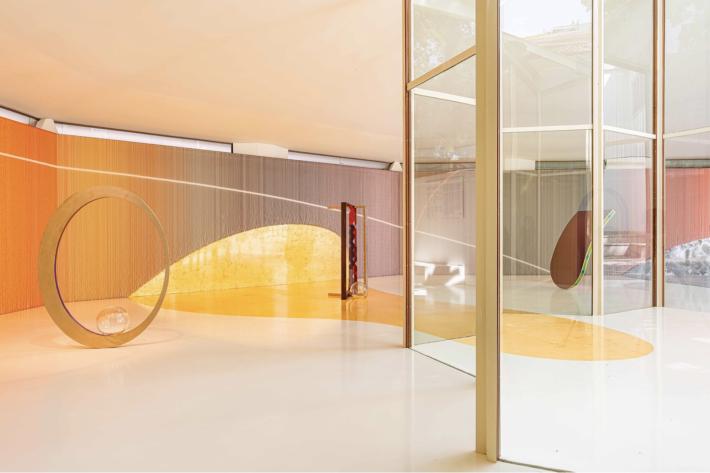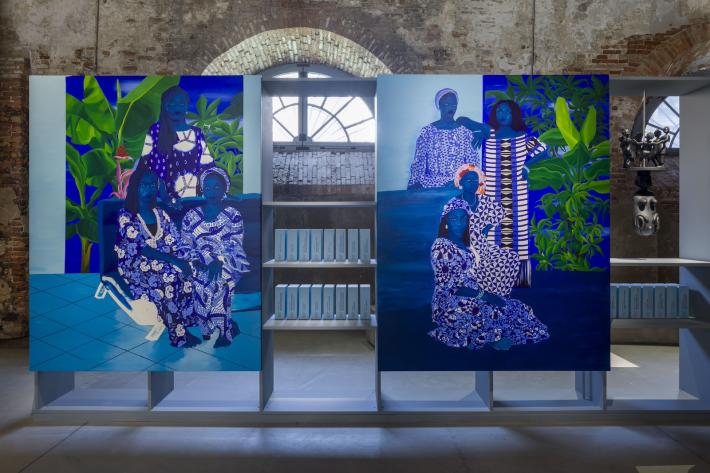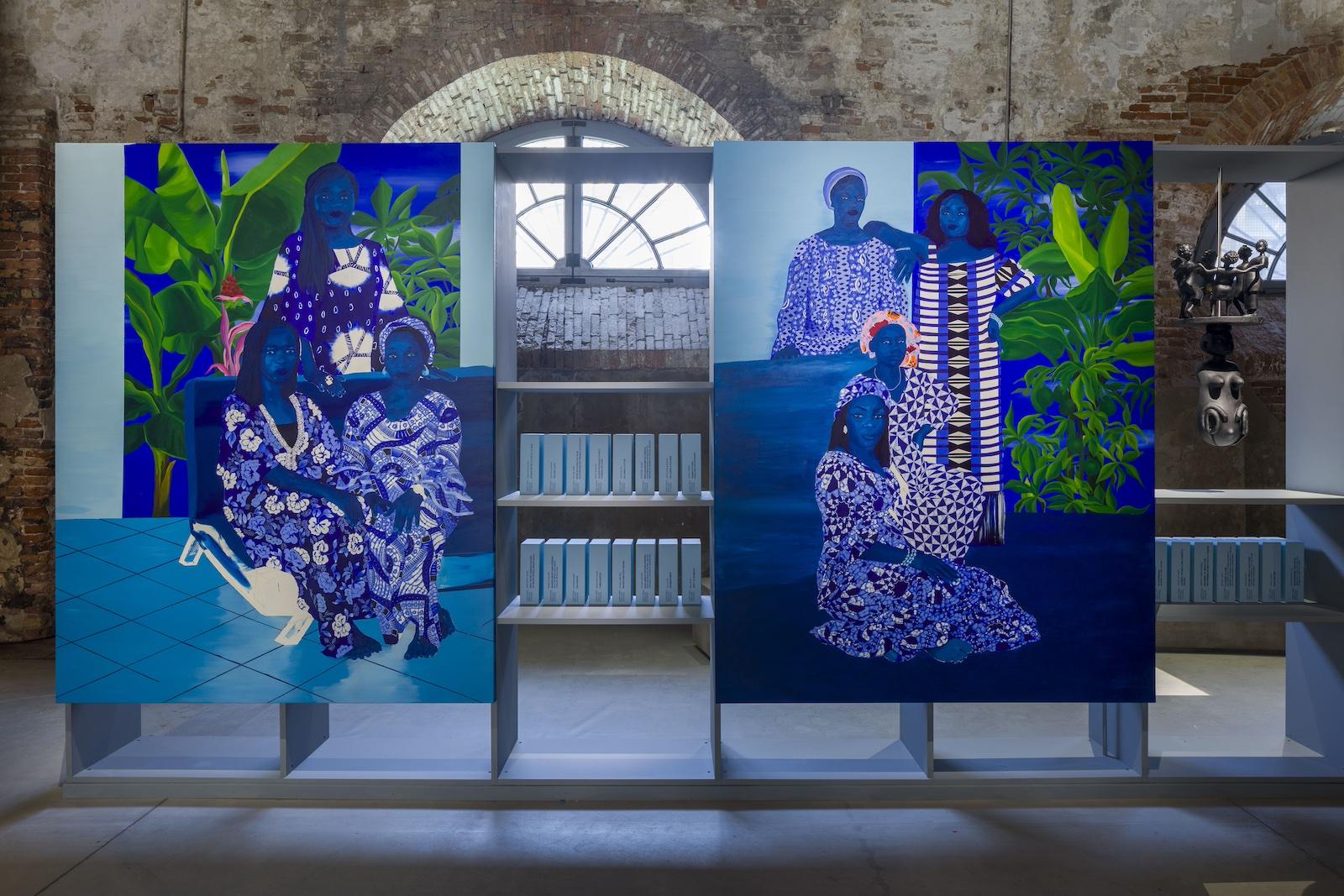
Installation view, Everything Precious is Fragile, 2024, Pavilion of Benin, 60th International Art Exhibition–La Biennale di Venezia. Moufouli Bello, détails "Egbe Modjisola", 2024
The 60th edition of the International Art Exhibition, titled “Foreigners Everywhere,” is a testament to how artists have always traveled and moved about under various circumstances. Curated by Adriano Pedrosa, artistic director of the São Paulo Museum of Art, the exhibition features 331 artists and collectives living in and between 80 countries. “Foreigners Everywhere” opened to the public on April 20 and runs through November 24, 2024.
“The backdrop for the work is a world rife with multifarious crises concerning the movement and existence of people across countries, nations, territories, and borders, which reflect the perils and pitfalls of language, translation, nationality, expressing differences and disparities conditioned by identity, nationality, race, gender, sexuality, freedom, and wealth,” Pedrosa states in his introduction.
During the Biennale previews, Venice was chock full of people from all walks of life—reflecting the true nature of the exhibition. The national pavilions and collateral exhibitions also explored the theme of “Foreigners Everywhere” in a spectrum of fascinating ways from various points of view, which has led our selection of shows to discuss.
These are our picks for the top ten national pavilions, which should be on every 2024 Venice Biennale visitor’s not-to-be-missed list.
The first indigenous artist to represent the United States in a solo pavilion in the Venice Biennale, Jeffrey Gibson is widely known for his paintings and sculptures that highlight traditional methods of patterning, textiles, and beadwork. Mixing vibrant abstract motifs with popular literary and musical references, he creates a colorful combination of inspirational art and language while exploring issues of identity. For Venice, Gibson constructed an interactive sculptural platform and graphic murals on the outside of the building and created new paintings, works on paper, beaded sculptures, and patterned murals—along with an energetic, 2020 multi-screen video—for inside the pavilion. Taken as a whole, the engaging works in the exhibition bring together American, Indigenous, and Queer histories to envision a new, more vibrant future.
A special project for the Applied Arts Pavilion, curated by Adriano Pedrosa— artistic director of the 60th International Art Exhibition— and presented in collaboration with the Victoria & Albert Museum in London, Beatriz Milhazes’ exhibition features a series of abstract paintings, collages, and tapestry inspired by textiles in the V&A collections and her personal holdings. The Brazilian artist, who represented her homeland in the 2003 Biennale Arte, mixes the hues and patterns appropriated from these textiles with her signature target, rays, waves, and floral motifs for her five large-scale Memórias do Futuro I (Memories of the Future I) paintings. Milhazes combines sweet papers and cuttings from print media in a group of seven spirited collages from 2013 to 2021, and weaves together geometric shapes and garden forms in her massive 2020 to 2022 tapestry, Pindorama— the indigenous Tupi-Guarani peoples’ word for the Brazilian territory before colonization.
The first Franco-Caribbean artist to represent France in the Biennale Arte, Julien Creuzet has created a multisensory, immersive experience that evokes an imaginary underwater landscape. Born in a Paris suburb, the 2021 Prix Marcel Duchamp nominee was raised in Martinique, where he was captivated by Caribbean culture. Best known for his suspended sculptures, videos, and floor pieces, the Paris-based artist, performer, and poet repurposes found materials to highlight the social realities of the Caribbean Diaspora. Visitors are greeted by a video of a shattered monument to colonization—the Quatre-Parties-du-Monde fountain with a globe, held by female nudes from the Jardin des Grands-Explorateurs—projected on the outside of the pavilion. Inside, his symbolic sculptures are intertwined with marine netting, ropes, and plastic consumer waste to construct the surreal illusion of a sunken city. Meanwhile, wall-sized screens display videos of dancing hybrid beings, stingray women, squid men, and swimming babies, accompanied by singing sirens and a poetic chant.
Turning the modernist Swiss Pavilion into a sensational stage-set for the sixth and seventh chapters of his allegorical saga “Superfictional World Atlas,” Swiss-Brazilian artist Guerreiro do Divino Amor ironically mixes videos and sculptures of goddesses personifying contemporary myths and sacred values, financial systems, and religion with symbols of power dating back to Roman times. “The Miracle of Helvetia” explores Switzerland as a make-believe model of beauty, richness, and perfection in a planetarium-like space. All the while, “Roma Talismano” offers video projections of the trans Brazilian artist and singer, Ventura Profana, as a mythical she-wolf, ewe lamb, and eagle—presented as a sculptural figure atop a pedestal amongst an architectural ruin—to comment on the Western concept of racial superiority, which the talented artist exposes as pure fiction.
Celebrated for creating sustainable ecosystems that employ everyday objects, Yuko Mohri follows in the footsteps of Marcel Duchamp, John Cage, and Nam June Paik by sourcing her material from the existing environment. Finding the elements for her “Compose” installation at local Venetian antique stores, furniture shops, grocery stores, liquor stores, produce stands, and flea markets, the Tokyo-based artist has filled the pavilion with radiating and acoustic sculptures made by rotting fruit attached to electrodes that generate light and sound and whimsical water sculptures that turn an environmental spotlight on the floating city, which has been repeatedly overcome by rising water levels. Rather than producing the works in her studio, Mohri spent time studying the site in 2023 and then returned to the pavilion—using it as a studio—to produce her enchanting Decomposition and Moré Moré (Leaky) installations over a six-week period.
Created through a collaboration with Saudi women who have made their collective voices known through song, speech, and drawings, Manal AlDowayan’s multimedia installation Shifting Sands: A Battle Song highlights the sonic and geological features of the desert. Constructing a maze of large-scale, printed silk, petal-like sculptures that take their forms from the desert rose, the Saudi artist silkscreened the surface of the blossoming sculptures with drawings and writings of workshop participants and texts about Saudi women, sourced from local and international news media. Based on the structure of battle ceremonies traditionally performed by Saudi men, AlDowayan’s sublime, sprawling sculpture echoes the crystalline formations found in the desert sands near her hometown, which she sees as a symbol of fragility, ephemerality, femininity, and resilience.
Inspired by a 1930s uprising in the Congo, artist collective Cercle d’Art des Travailleurs de Plantation Congolaise (CATPC) have created 21 sculptural figures that are symbolic of the forced labor and rape by the Belgian colonialists and a massacre of the Congolese people that followed. Referencing a carved-wood statue depicting the angry spirit of a Belgian officer, lent by the Virginia Museum of Fine Arts to a simultaneous CATPC exhibition in Lusanga and live-streamed to visitors of the Dutch Pavilion, the figurative sculptures were made in clay by members of CATPC to depict the scenes of the uprising. They were then recast in palm oil, sugar and chocolate in Amsterdam. Created in collaboration with artist Renzo Martens and curator Hicham Khalidi, the exhibition highlights CATPC’s effort to reclaim depleted plantation lands and to restore the Sacred Forest with a wider mission of spiritual, ethical, and economic retribution.
A Serbian visual artist, stage designer, and film production designer, Aleksandar Denić has spent the past several decades as a displaced person, living in Germany and German-speaking areas while working for theaters and opera houses across Europe, and on various feature films as well. Employing his skills in set design, he constructed a pavilion exhibition that looks like a small shopping center from 50 years ago. With a cinema ticket booth at the entrance, food stands, photo automat, Coca-Cola fridge, phone booth, jukebox, and signs for Castrol Oil and BP, the pavilion has all the exports for European and American exploitation and transformation of colonial countries during the 19th and 20th Century. As a citizen of a country that was part of the Soviet Bloc when it was known as Yugoslavia, Denić experienced the same sort of consumerist campaigns by Western companies when the Cold War came to an end. Unfortunately—as the artist’s well-crafted presentations recalls—the subjugation of peoples and cultures continues today.
Tracing the history of glass seed beads made in Murano and used as currency and items of exchange beginning in the 16th Century, Kapwani Kiwanga utilizes the tiny beads to transform the Canadian Pavilion into a colorful, minimalist realm—both inside and out. A multi-disciplinary Canadian and French artist based in Paris, Kiwanga has draped an outer brick structure, and part of the façade of the building, with beads and covered the walls of the inner gallery with a shifting palette of beaded hues. Occupying the super-graphic-defined floor are a series of geometric sculptures made in wood, metal, bronze, and steel decorated with glass beads, paint, and palladium leaf and accompanied by sculptural objects in blown glass. An immersive, aesthetic experience to behold and walk through, the artist’s installation uplifts the spirit while reminding visitors of the place that the onetime trading capital played in the culture of the East and the West.
Making its Venice Biennale debut, the Pavilion of the Republic of Benin is presenting a group show with four Beninese artists and an unexpected theme of feminism. The feminism that curator Azu Nwagbogu is proposing is not the European version of women’s equality, but rather the Mother Earth variety, where life and nature are feminine and the primordial mother Iya Nla—the spirit of all creation in Yoruba cosmology—is the source of all existence. Inspired by the identification and restitution of 26 traditional objects to Benin from Paris’s Quai Branly Museum, “Everything Precious is Fragile” proclaims that culture needs to be valued. Romuald Hazoume’s dome made from recycled containers constructs a sacred space at the center of the pavilion. While Moufouli Bello beautifully captures African women on canvas at the social center in shades of blue, Chloe Quenum creates a silent orchestra with suspended instruments cast in glass, and Ishola Akpo appropriates images of African kings with women assuming the roles of the royals.
Paul Laster
Paul Laster is a writer, editor, curator, advisor, artist, and lecturer. New York Desk Editor for ArtAsiaPacific, Laster is also a Contributing Editor at Raw Vision and Whitehot Magazine of Contemporary Art and a contributing writer for Art & Object, Ocula, Galerie, Artsy, Sculpture, Time Out New York, Conceptual Fine Arts, and Two Coats of Paint. Formerly the Founding Editor of Artkrush, he began The Daily Beast’s art section and was Art Editor at Russell Simmons’ OneWorld Magazine. Laster has also been the Curatorial Advisor for Intersect Art & Design and an Adjunct Curator at P.S.1 Contemporary Art Center, now MoMA PS1.




